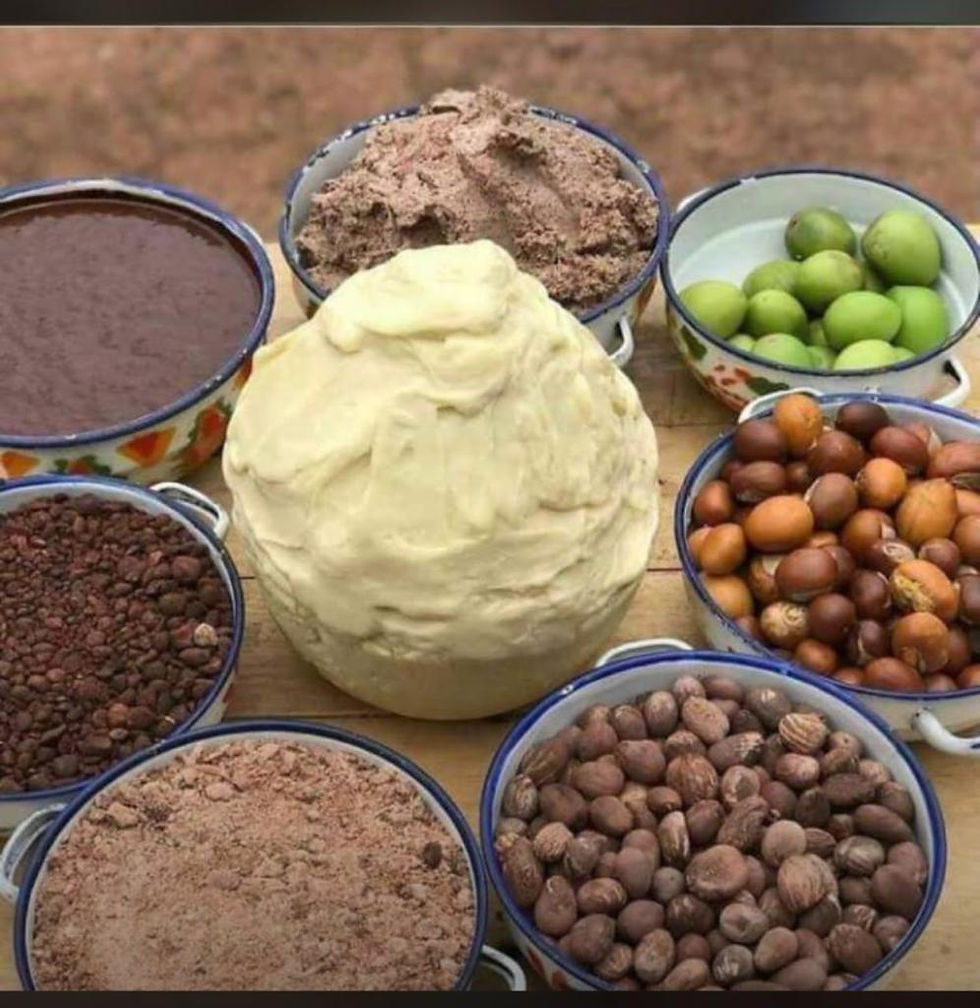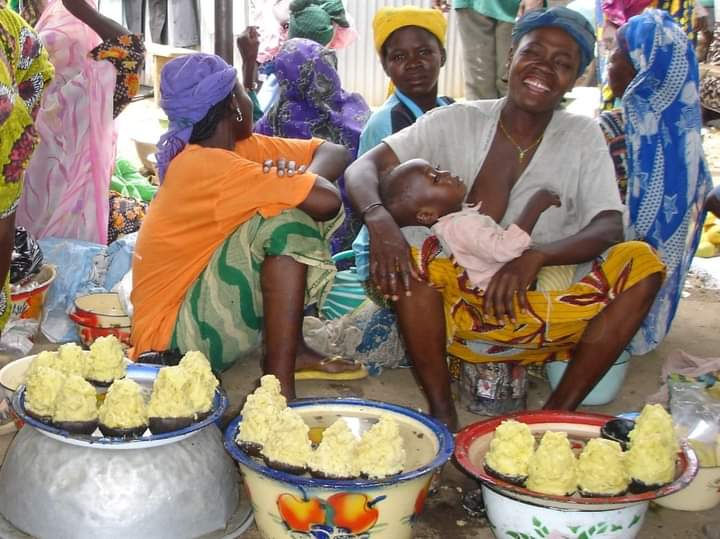The Globalization of Shea Butter
- Dana Rovang

- May 8, 2024
- 6 min read
From trees to vanities.
By Sophie Adekola
Òri, Òkwùmá, Kade, Karité, Nkuto; shea butter is all of these names and more in different African cultures. If you have a skincare or haircare routine, chances are, you’ve had this multi-use butter on your skin or hair in some form.
The globalization of shea butter represents an ever-evolving bridge between African markets and the rest of the world. Per Grand View Research, the global shea butter market was valued at $2.17 billion in 2022, a figure set to grow at a rate of 7.1% from 2023 to 2030.
From its benefits when applied raw to being an useful ingredient in hair and skin products, shea butter has a wide range of beauty-related and even culinary uses that drive its market.
Read on to follow the history of this natural butter’s journey from proud beginnings in Africa to vanity tables around the world.
Shea Butter Explained: A History of Roots
Shea butter has its origins in African countries, particularly the Sudano-Sahelian region which cuts across West and East Africa. It is an edible, oil-soluble ivory to yellow butter that comes from the seed (nut) of the fruits of the shea tree, Vitellaria paradoxa (syn. Butyrospermum parkii).
The shea tree, or karite tree, has been referred to in Scientia Africana as the “tree of life” because it offers a variety of beneficial uses, including the use of its flowers and fruit to treat illnesses such as arthritis.
Shea butter is listed by the INCI as a moisturiser, antioxidant, anti-inflammatory, skin conditioning and viscosity controlling agent due to its fatty acids and nourishing vitamins.
It also helps combat UV irradiation to a mild extent by protecting the skin from sunburn with a Sun Protection Factor of 3-4.
How Shea Butter Is Made: A History of Seasons
Traditionally, the production of shea butter involves a series of manual processes that begin with harvesting and typically take a few days to weeks, depending on the size of the crop.
The shea tree produces ivory flowers that develop into green fruits and turn brown when ripe. This development takes place over a four-month period that begins in May every year during the wet season. The ripened fruits fall to the ground of their own accord, ready for picking by hand.
In this case, the words “fruit” and “nut” are used interchangeably, and the shea butter itself is made from the kernels inside the nuts. The shea nuts are sun-dried or oven-dried for days until brittle. The dried shea nuts are then broken with stones, hammers or pestles to remove their shells and reveal the kernels.
There is a long tradition of using the natural elements from the area to help process the butter. For instance, sorting is done by facing specialized baskets containing the mixture of shells and kernels in the direction of the wind, where strong wind blows the lighter shell pieces away.
The leftover shells and subpar black shea kernels are sorted out by hand, leaving the clean, unbroken, brown kernels behind. The kernels are roasted and ground with water into a thick brown paste.
The paste is mixed thoroughly for about an hour as depicted in this video from BBC News Africa, and water is added to cause the shea butter content to rise to the top. It is then extracted, heated into oil, and allowed to cool into raw shea butter. The shea butter is packaged in jars, ready to be sold.
Shea Butter Globalization: A History of Trade
The production and trade of shea butter has long been linked to women. It has earned itself the alias, “women’s gold” for being a source of income to an average of three million African women, as stated by the United Nations Development Programme.
The rich history of shea butter production and even its use spans centuries from the time of Queen Cleopatra’s reign(51-30 B.C.) when it was stored in clay jars and transported using caravans. Gas chromatography-mass spectrometry of the hair of ancient Egyptian mummies from 2600-3500 years ago also revealed the use of a stearic acid-rich material which may have been Shea Butter.
While the above is mostly speculation, studies of the Kirikongo archaeological site in Burkina Faso show numerous carbonized shea nut shell fragments. Since the village was occupied from 100-1700 CE, this confirms shea butter production at the time.
Shea butter’s production and trade journey can also be followed through mentions of it in traveller records such as those of Mungo Park. From 1795 to 1797, the Scottish explorer journeyed West Africa through Senegal and Mali where he "discovered" shea butter and brought about its introduction to Western Science.
Park documented his observations in his book, Travels in the Interior Districts of Africa, where he wrote of the harvesting, production and use of shea butter. He described it as a commodity with several purposes including cooking, medicine, skincare and even currency.
He also took samples of shea butter to Europe upon his return. His accounts and samples sparked interest in the European merchant community, inciting an exploration of the potential of this butter in Western commerce.
In the early 1900s, experiments on shea as an exportable cash crop began. French and British colonies in Africa began to export the nuts and butter to Europe. However, the exports were sold for as little as a sterling per ton in Liverpool because a mass market did not exist for it outside Africa.
The shea tree and shea butter gained significance in the 1970s when the tree was announced as one of six plant species whose vegetable fat could double as a key ingredient in pharmaceutical and cosmetics industries and an alternative to cocoa butter in the production of chocolate.
According to an article by the UN, the top shea nut–producing countries are Nigeria, Mali, Burkina Faso, Ghana, Côte d’Ivoire, Benin and Togo. Shea was so important to the Ghanaian economy that its trade was regulated by the government.
Eventually, it was handed over to the private sector in 1992. By the 2000s, a small number of extraction and fractionation firms were established, rendering hand extraction techniques obsolete. An example is The Savannah Fruits Company headquartered in Tamale, Ghana.
Another example is Naa Sakle International, a shea processing plant set up by West African entrepreneur, Eugenia Akuete in northern Ghana. Akuete also became the first president of the Global Shea Alliance, a body aimed at advising governments and organizations about shea butter trade, standards and sustainability.
As a result of these moves, shea export numbers began to increase. By the end of the decade, exports reached a peak, and the Shea sector began to receive recognition and support from NGOs and donors, particularly the European Union(EU) and the United States Agency for International Development(USAID).
The following decade featured USAID and EU projects focused on the roles played by shea-collecting women, and plans to increase extraction plant operation in target African countries with an aim of ultimately processing the shea crop using automated machines.
Shea Butter And The Beauty Industry
The globalization of shea butter as a beauty product cannot completely be described without mentioning L’Occitane and The Body Shop. These two companies were some of the early drivers of shea butter cosmetic trade.
In 1994, The Body Shop began a partnership with the Tungteiya Women’s Association of Ghana; a trade relationship in which the women were paid fair prices for producing shea butter.
While The Body Shop has a shea butter range that varies from packaged shea butter to shampoo and conditioner products with labels that blatantly say “SHEA”, there are beauty brands that are more subtle about it.
For example, the Bobbi Brown Skin Cream Foundation Stick has shea butter listed as one of its ingredients. The Divine Blush from PatMcGrath Labs is also infused with shea butter. South Korea is not left behind as the Lip Sleeping Mask from Korean beauty brand, Laneige, also has shea butter as one of its key ingredients.
Takeaway
The globalization of shea butter is a phenomenon with both positive and negative influences. While the increased demand for shea butter has created income opportunities for African women, it also brings up issues such as sustainability and fair trade practices.
As shea butter continues its journey around the world, it is important for suppliers, wholesalers, stakeholders and all players in this sector to find a balance so that these negative implications do not outweigh the benefits that the globalization of shea butter offers.
Additional Reading
Kolawole O. M., Usifo R. O. (2023). Physicochemical Characterization of Shea Butter From Kaima, Nigeria. Scientia Africana, Vol. 22, No. 1.
Sam Moore. (2008). The role of Vitellaria Paradoxa in Poverty Reduction and Food Security in the Upper East region of Ghana. ResearchGate.
Rebecca Moudio. Shea Butter Nourishes Opportunities For African Women.
Daphne E. Gallagher; et al. (2023). The Archaeology of Shea Butter (Vitellaria paradoxa) in Burkina Faso, West Africa. Journal of Ethnobiology, Sage Journals.
Julia Bello-Bravo; et al. (2015). The Evolution of Shea Butter's "Paradox of paradoxa" and the Potential Opportunity for Information and Communication Technology (ICT) to Improve Quality, Market Access and Women's Livelihoods across Rural Africa. MDPI.
Brenda Chalfin. Shea Butter Republic - State Power, Global Markets, and the Making of an Indigenous Commodity.
Ademola, A. O.; et al. (2012). Assessment of Shea Butter Processing among Rural Dwellers in Atisbo Local Government Area of Oyo State, Nigeria. European Journal of Business and Social Sciences. Vol-1, No. 7, October 2012. Pages 1-8.















Comments